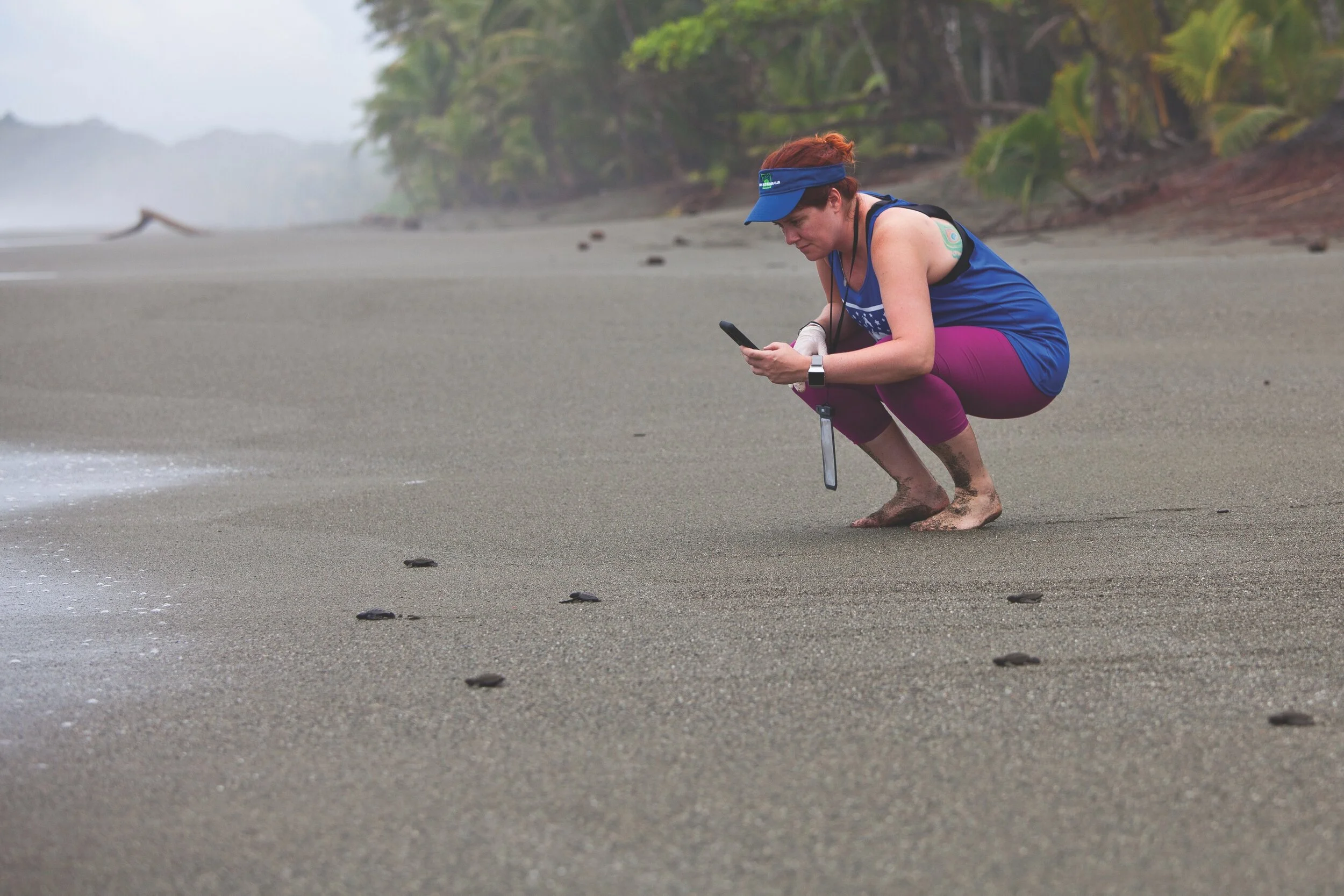Top Smartphone Apps for Sea Turtle Work
By CRAIG TURLEY
A citizen scientist uses her smartphone to photograph olive ridley hatchlings on Piró Beach, Costa Rica. © Brian J. Hutchinson
Smartphones and tablets have the potential to revolutionize the way we collect data on sea turtles and other species by putting powerful technology in the palms of our hands when and where we need it most. Although this field is still growing, a variety of mobile applications (apps) have already been developed to harness mobile technology for sea turtle research and conservation, taking advantage of the standard sensors and other tools that are found in today’s mobile devices.
Apps offer a number of advantages to traditional paper-based data collection. They can minimize data input errors; reduce time- consuming manual data entry; quickly and automatically generate spreadsheets; capture lots of data automatically (e.g., time, date, location, photos, videos, and sound recordings, as well as weather, moon phase, and more); and automatically upload data to the cloud to reduce the risks of data loss. They also offer features and potential uses that traditional data collection methods do not, such as the ability to create and use interactive maps, to facilitate collaboration by uploading data to a shared database, and to harness the power of citizen scientists on a large scale.
HOW TO CHOOSE AN APP
With a growing number of mobile apps on the market, it can be difficult and time consuming to research the strengths and weaknesses of each and to determine the best app to support your goals. Many projects consider developing their own apps, but it is worth first exploring what already exists. This article provides an overview of some of the most popular apps that are currently available for sea turtle research and conservation, and it can be used as a starting place for researchers looking to incorporate this technology into their programs. Here are a few important things to consider when choosing an app:
Data accessibility and storage. Some researchers may need exclusive access to their data to allow for a more detailed analysis and eventual publication. They may therefore want to avoid apps that make data publicly available through open-source databases. However, apps that do make data publicly available can offer the potential for greater collaboration and public outreach and can also attract broader contributions of useful data. Some open-source apps make higher- resolution data available by request, using data protection protocols that ensure exclusivity when needed.
Cost and convenience. App development can be costly and time consuming, and it often requires technical know-how beyond that of most sea turtle researchers. Using an off-the-shelf app that is available through the Google Play Store or the Apple App Store may be the best choice for budget-constrained projects. However, there will generally be trade-offs, and paying more for a customized experience definitely has its advantages. Beyond the apps themselves, buying (and replacing) mobile phones or tablets can be a large investment, and access to mobile networks can require subscription fees.
Stability, support, and longevity. Before committing to an off-the-shelf app, it is a good idea to do some homework about the app developer and to research how widely used the app is. Some apps have huge communities of users, robust technical support, and a developer that is committed to maintaining the platform (for example, iNaturalist), whereas others may have been built by a small team with no plans or funding for future maintenance and little or no capacity for user support. With the high frequency of updates to mobile operating systems and to mobile devices themselves, unsupported apps are more likely to develop bugs over time.
TODAY’S SEA TURTLE APP OPTIONS
The table below summarizes some of the apps now available for sea turtle research and conservation and provides a brief overview of key features. This guide is not exhaustive, and the pace of technology makes it a moving target, but it can be a starting place for researchers and conservationists exploring using this valuable technology to enhance their work in 2020. Nearly all of the apps can be found online or in either the Apple App Store or Google Play Store. Instructions are provided for requesting those apps that are not readily available.
This article originally appeared in SWOT Report, vol. 15 (2020). Click here to download the complete article as a PDF.


